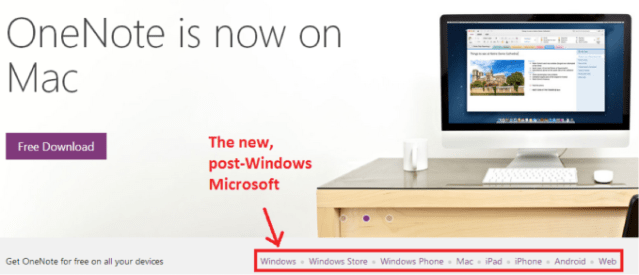As reported on TechCrunch.
by Peter Yared
 Editor’s note: Peter Yared is the CTO/CIO at CBS Interactive.
Editor’s note: Peter Yared is the CTO/CIO at CBS Interactive.
Microsoft had become an oft-ignored, behemoth to the North, despite $77 billion in revenue, $57 billion in gross profits and $21 billion in net income. It seemed that the mobile revolution had passed it by. Although Steve Ballmer was already making many of the right moves, it took new CEO Satya Nadella to fully accept that Microsoft had to move beyond Windows into a new future of apps and cloud services.
The future of Microsoft is in selling its software, such as Microsoft Office 365, Microsoft Dynamics CRM and ERP, and Microsoft servers in the Azure cloud to business customers on whatever platform they like. Each of these products is arguably best-of-breed and cloud-based, and has a large customer base. Microsoft indeed has the ability to pivot, and pivot hard, as it did when it switched from pushing MSN to competing with Netscape in the Internet space. And Microsoft is once again not encumbered by antitrust restrictions from aggressively pursuing these markets.
There was a time when, if Redmond aimed its guns at a market segment, startups fled. Since the launch of the iPhone almost seven years ago, Silicon Valley startups have operated without any fear of Microsoft competing aggressively in apps and device-agnostic cloud services.
As the first step towards its new OS-agnostic future, Microsoft recently released its OneNote note-management software for the Mac OS, rounding out a full multi-platform strategy for the software, including Windows, Windows Phone, Mac, iPad, iPhone, Android and web.

Microsoft quickly followed up with Office 365 for iPad, in addition to its existing Android, iPhone and Mac support. Microsoft Office 365 is remarkably good, and offers a web only option that is priced the same as Google Drive with far better features and the familiarity of Office. Power users can pay more per month for small business premium that includes the desktop versions of the apps, so an IT department can offer different versions to different types of users. Office 365 now only has three different versions, versus the headache-inducing menu from years past. Most business buy Microsoft software through enterprise license agreements which will bypass the Apple 30 percent cut.
Although it is a huge step for Microsoft Office to now be available on all of these platforms, just touch-enabling software does not necessarily make it mobile first. Microsoft has to keep a sharp eye on startups like Quip that have completely rethought the office experience for mobile.
Microsoft Dynamics CRM and ERP are a billion dollar plus business and growing rapidly. Dynamics CRM is available as SaaS on all platforms including iOS and Android. Dynamics ERP is available as a cloud hosted solution but is not yet available on other client platforms.
Windows Azure cloud, which is rumored to be rebranded to “Microsoft Azure,” is also growing rapidly and provides a growth platform for .Net development platform, Microsoft’s Windows Server, Active Directory, and SQL Server database products.
Microsoft has an army of loyal developers who love its easy-to-use tools, and it is rumored that it’s going to acquire Xamarin, which lets Microsoft .Net developers build apps for iOS and Android. The companies recently signed a partnership, but an acquisition of this technology would be a huge step forward for Microsoft’s new mission of platform agnosticism.
So what of Windows?
Microsoft is not giving up on Windows, but it is going to stop tying its growth products to only one operating system. Windows 8.1, for all of its faults, is the same as Windows 7 once you ignore the Modern UI. And on a tablet, the Modern UI actually works quite well. I have been using a Lenovo Yoga exclusively for almost a year and have actually quite enjoyed it despite its quirks. In addition, Windows Server is seeing a renaissance as part of Azure cloud.
There is a report that Microsoft is seriously considering giving away a version of Windows 8.1, much like Google gives away Android and Chrome OS in order to drive more Google Search revenue, and Apple now gives away Mac OS upgrades.
Microsoft’s OEMs have been struggling to increase margin and have been extracting lower Windows licensing fees and even no licensing fees in some cases. However, these discounts could be used as a lever to finally get hardware OEMs into line with more stringent hardware standards.
With a free Windows on decent hardware and a $99 Office 365 home subscription, Microsoft can retain legions of value-oriented consumers (think Costco shoppers) that want to use the same computer at home that they use at work. While some urban Apple devotees may look with disdain on this strategy, there are many high growth, high profit companies that sell exclusively to middle America.
The saving grace for Windows Phone is that at some point, the apps market is going to calm down, and there will be 1,000 apps that matter to 99 percent of the population. Microsoft can pay each of those app developers up to $500,000 to port to Windows Phone, so it would cost $500 million for Microsoft to offer a phone that has the top 1,000 apps. Quite achievable for a company that has a $2.5 billion annual marketing budget and more than $100 billion of cash. The much-maligned Surface tablet is now a break-even business with almost $1 billion in sales. Even if consumers don’t buy them, Microsoft is selling large volumes to businesses such as Delta.
The operating system story for Microsoft is now one of slow growth and middling progress, which keeps it somewhat in the game without bogging down its application growth engines.
The other businesses
As many an analyst has stated, the Xbox and Bing businesses should be spun out. One option is to sell Xbox to troubled Sony so it can combine the declining consoles market into a single larger entity and gain efficiencies in production and retain AAA game developers. Yahoo could pick up Bing in order to accelerate its renewed focus on search.
Perhaps I have a tendency to favor the underdog, but Nadella has a great shot to make Microsoft relevant again with its new focus on selling its high-growth software to businesses on whatever platform they want. There was a time in the early 1990s when Microsoft made more money on every Mac sold than Apple did. With its new platform-agnostic strategy, this is a metric that Microsoft could attain again for every device sold to a business.